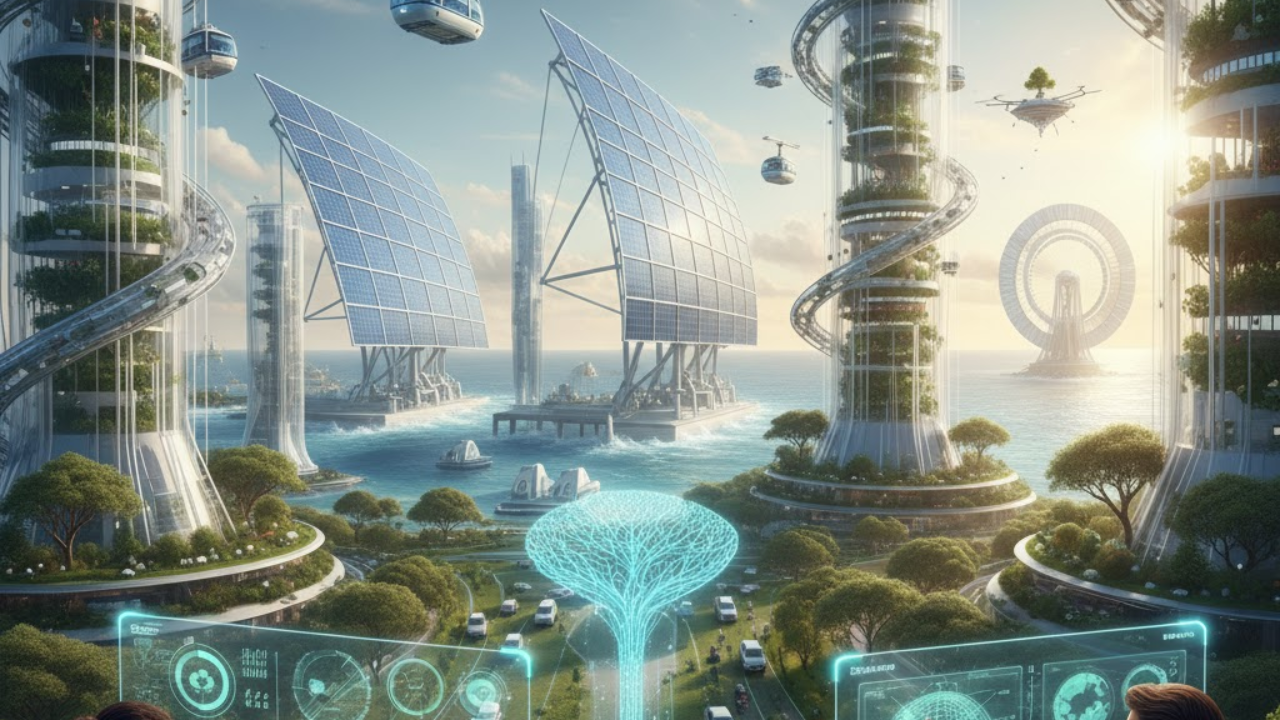
Post by : Naveen Mittal
The climate crisis is no longer a distant threat — it’s a daily reality. But while the planet warms, so does human innovation. Across labs and startups worldwide, technology is rapidly reshaping how we fight climate change, unlocking new ways to capture carbon, create solar-based fuels, and design eco-friendly materials that could redefine sustainability.
In 2025, the fight against global warming is being powered by a fusion of science, artificial intelligence, and green engineering — and the results are beginning to turn the tide.
From direct air capture plants to AI-driven energy grids, climate technology is no longer just about reducing emissions — it’s about removing, reusing, and reinventing the very systems that fuel the modern world.
Analysts estimate that the global climate tech market will surpass $1.5 trillion by 2030, driven by breakthroughs in carbon capture, renewable energy storage, and green manufacturing.
Governments, investors, and innovators are finally aligned under one mission: decarbonize the planet through technology.
Carbon capture is the process of trapping CO₂ before it enters — or after it’s already in — the atmosphere. Once dismissed as too costly, it’s now one of the fastest-growing green technologies on Earth.
Companies like Climeworks, Carbon Engineering, and Global Thermostat have built massive DAC facilities that pull CO₂ straight from the atmosphere using chemical filters and renewable-powered fans.
The captured carbon can then be stored underground or reused to create fuels, plastics, or even building materials.
Each Climeworks plant can now remove over 36,000 tons of CO₂ annually, equivalent to the emissions from nearly 8,000 cars.
Startups are turning captured carbon into profitable resources — a concept known as “carbon utilization.”
CarbonCure injects captured CO₂ into concrete, making it stronger and greener.
Twelve uses renewable electricity to transform CO₂ into synthetic jet fuel and industrial chemicals.
Air Company produces carbon-neutral vodka and perfumes from captured emissions.
These circular solutions prove that carbon capture can be both environmental and economical.
Imagine creating gasoline not from oil wells but from sunlight and air — that’s the promise of solar fuels, a revolutionary field combining photochemistry, nanotechnology, and AI.
Solar fuels are produced using artificial photosynthesis, a process that mimics how plants convert sunlight, water, and CO₂ into energy.
By using catalytic materials and light-absorbing nanostructures, researchers can split water molecules and recycle CO₂ into hydrogen, methanol, or synthetic hydrocarbons.
Unlike traditional fossil fuels, solar fuels are carbon-neutral — the CO₂ they emit when burned is the same amount used to make them.
This makes them ideal for powering sectors hard to electrify, such as aviation, shipping, and heavy industry.
Companies like Synhelion, Sunfire, and H2Pro are scaling up pilot plants that can produce solar fuels at competitive prices, while nations like Germany, Japan, and the U.S. are investing billions to bring them to market.
With solar fuel production expected to exceed $30 billion by 2032, it’s emerging as one of the most promising climate technologies of the decade.
While clean energy grabs headlines, green materials are quietly transforming manufacturing, construction, and consumer products.
Innovators are replacing petroleum-based plastics with biodegradable alternatives made from algae, sugarcane, or agricultural waste.
NatureWorks produces Ingeo, a polymer derived from corn that decomposes naturally.
LanzaTech converts industrial emissions into sustainable ethanol for packaging and fabrics.
These materials reduce plastic waste while cutting dependence on fossil-based raw materials.
Construction accounts for 40% of global CO₂ emissions — but that’s changing.
New materials like carbon-negative cement, hempcrete, and graphene-infused composites are slashing the carbon footprint of buildings while improving strength and insulation.
AI is also helping architects design “net-zero buildings” that generate more energy than they consume, using advanced modeling and smart materials.
The fashion industry is adopting nanocellulose fibers, lab-grown leather, and spider silk substitutes made through synthetic biology.
These innovations reduce pollution, animal harm, and textile waste — making sustainability fashionable in the most literal sense.
Artificial intelligence is playing a pivotal role in accelerating these breakthroughs.
Predictive AI models optimize carbon capture plant operations.
Machine learning speeds up solar fuel research by simulating millions of chemical reactions.
AI-powered climate modeling helps governments plan emission reduction strategies with greater accuracy.
Google’s DeepMind recently trained an AI model that reduced energy use in data centers by 40%, proving that AI is not only part of the solution — it is the solution.
The race to net-zero is shaping global politics and business strategies.
The European Union has launched its €250 billion Green Deal Industrial Plan to boost green tech manufacturing.
The U.S. Inflation Reduction Act (IRA) offers major incentives for clean energy, carbon capture, and EV infrastructure.
China leads in renewable production, controlling over 80% of the world’s solar panel and battery supply chain.
India and the UAE are emerging as new climate innovation hubs, investing in carbon capture and solar hydrogen projects.
This global competition is accelerating progress — turning sustainability into both an economic opportunity and a geopolitical asset.
The future of climate action won’t depend on one invention — but on the integration of multiple innovations working in harmony.
Carbon capture removes what’s already there.
Solar fuels create clean energy for what’s next.
Green materials ensure sustainability in what we build.
Together, they represent a complete cycle of regeneration, where technology no longer takes from nature — but works alongside it.
As one climate engineer aptly said: “The next industrial revolution won’t be powered by oil or coal — it will be powered by imagination.”
The world is at a tipping point — but also at a turning point.
Through AI, nanotech, and green innovation, we’re learning how to engineer sustainability at every scale — from molecules to megacities.
The technologies being built today won’t just slow climate change — they’ll redefine what progress means for generations to come.
And for the first time in history, the future of the planet lies not just in policy or protest, but in code, chemistry, and creativity.










NBA Friday Recap: Powerhouse Wins for Miami, LA, Milwaukee, and Clippers
Miami, LA Lakers, Milwaukee, and Clippers triumphed in a thrilling NBA Friday, showcasing standout p

Doncic Shines with 49 Points in Lakers' 128-110 Victory over Timberwolves
Luka Doncic dazzles with 49 points as the Lakers secure a 128-110 win against the Timberwolves, show

Kings Triumph Over Jazz 105-104 with Last-Minute Sabonis Effort
The Sacramento Kings edged out the Utah Jazz 105-104, with Domantas Sabonis making the decisive shot

Argentina's Friendly Match Against India Delayed, New Date to be Announced
The friendly match between Argentina and India in Kochi has been postponed due to FIFA approval dela

Rohit and Kohli Conclude ODI Journeys in Australia with a Victory
Rohit Sharma and Virat Kohli bid adieu to Australian ODIs with a final win, forming a 168-run partne

George Russell's Wrestling Mask Antics at Mexican Grand Prix
George Russell donned a wrestling mask to enjoy the Mexican Grand Prix from the stands, providing a